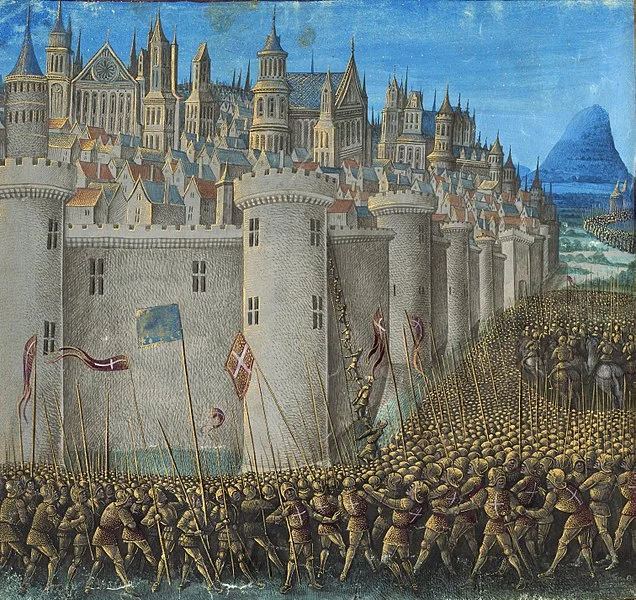Not Today: The Tactical-Dramatic Tightrope of the Battle of Winterfell
In case a prior warning went unseen or unheeded, know’st thou the following reflection is riven through with spoilers for Game of Thrones, Season 8, Episode 3. There’s a zillion and a half written responses to this episode scrambling over the internet’s walls, so mine’s going to focus on medieval combat and how and where realism should be tempered for dramatic effect.
As I’ve mentioned in my posts about stage combat, I try to keep balance between my serious study of knightly martial arts/interest in military history, and the fact that I’m a professional pretender who makes stuff up so people laugh/cry/go home and rethink their lives. Whatever your discipline is - medicine, history, architecture - remember that accuracy in fiction isn’t a straight line with ‘least accurate=worst for story’ and ‘most accurate=best for story’ on opposite ends. The question is, ‘Does the accuracy level of part X enhance or diminish the effectiveness of the story?’
A Song of Ice and Fire is a masterwork of balancing medieval realism and high fantasy bombast. On one hand, Westeros has an intricate feudal hierarchy of high kings, regional lords, petty nobility and landed knights. The crystal lattice of loyalty fractures under too much strain, with lower lords clamoring to usurp their superiors’ place in the eyes of the crown. On the other hand, the series’ main story is The Ancient Evil Is Waking Up To Destroy The World™. On one hand, serfs rousted from the field under their lords’ whips and hurled into the fray with a spear and a pat on the back, cut down by knights whose high birth gives them the weapons, armor, and martial training to literally run roughshod over their social inferiors. On the other hand, DRAGONS!!
What this episode does brilliantly is convey the sensation of absolutely overwhelming numbers. The first wave of dead crashing against Unsullied shields is a literal wave, with crests and troughs. This is not a battle that can be won. It can only hold off the horde for long enough that somebody kills the Night King. That in mind…
I’m going to breeze past ‘why is anyone outside the wall instead of packed on the battlements?’ You obviously should use a castle if you have one. However, this glaring tactical inaccuracy serves an extremely important dramatic structure purpose: A pitched battle on an open field, filled with thrilling action and terror, with a natural transition to the second act as the line starts to break and is forced to retreat. Fair enough. Let’s get more specific about the Dothraki and the Unsullied:
The Ride of the Dothrahirrim(You know you hummed the Rohan theme when they charged) is beautifully dramatic and very stupid. I adore the haunting scene of the flames being snuffed out, but you could modify it so it’s not so dumb. At the simple level, armies fight best when all parts work together for mutual support and protection. Splitting off a piece of your force and sending it beyond all help, hurling it against overwhelming forces, is utterly pointless. At the detail level, the Dothraki aren’t heavy shock cavalry - cavalry for charging headlong into the foe. Shock cavalry needs armor on both rider and horse, and a reach weapon like a lance. The Dothraki are light skirmish cavalry. You don’t take the best light cavalry in the world and run straight at the other army. You keep them nimble to screen your force, move quickly to protect the flanks, close gaps in the line and rush to wherever you’re having trouble.
Okay, but we want that gorgeous scene of chilling dread. We can still do that. What else are light cavalry for? Oh yeah! Scouting! We haven’t even mentioned the fact that they’re not just doing a mass charge, they’re doing a mass charge into an enemy they can’t see. Let’s fix both those issues. Jorah leads a detachment, a sufficiently dramatic number like one or two hundred riders, to scout the opponent’s position. Melisandre lights up their swords, and they ride out ablaze. Tension mounts as they get farther away. Where is the undead host? Are they even here yet? Then you hear the weapons clashing, the screams, and one by one the light of hope winks out. A few survivors straggle back, and rather than being the humiliated dregs of a futile action, they did their job. They found the enemy. The rest of the Dothraki now have personal vengeance to wreak as they do what they should actually be doing, supporting the infantry’s flanks and gaps. Those trebuchets, which should’ve been either inside the walls or at least farther back, now know where to shoot. They start flinging fireballs and can maintain a sustained fire.
The Unsullied, by contrast, were used very well - again, ignoring the whole ‘outside the walls’ part. Their disciplined, tight phalanx of spears and shields is exactly what you want holding down your center. I particularly appreciated their orderly withdrawal, shifting as one and closing ranks to cover the retreat through the gate. I think we could’ve given the survivors a second task in act II, though: Manning the damn walls. As the swarming dead overwhelm the ditch and claw their way toward the battlements, imagine how cool it would be if between every crenellation there was an Unsullied soldier barring the gap with shield and spear. Imagine the Spartan-like commands and chants echoing in the air as the soldiers lean forward in sync, stabbing methodically at the dead climbers, severely slowing their assault.
How bout that fiery ditch? Great, pretty, love it. I’d change one thing though: The defenders should’ve left a hole in it. Basic principle: You’ve got a defensive work surrounded by overwhelming numbers. Inevitably, some part of it will fail. Maybe several parts at once. If you make a small section deliberately weak, you create your own Hot Gates. You can focus a large part of your force on a small gap that the enemy can only come through so many at a time. Because these enemies are stupid zombies, they won’t be smart enough to understand what’s going on and will keep piling into your choke point. Tactically sound. Dramatically, you now have a mini 300 in your battle sequence. A’OO!
I don’t have much to say about the dragons. I think they were used well, either doing strafing runs on the dead or protecting the castle from zombodragon™. I liked the freezing winds as an explanation why they weren’t doing more, being a sort of medieval-magical ‘electronic countermeasures,’ blinding aircraft to limit their effectiveness.
I apologize for adding my harp to the great harp orchestra that already harps on this, but: Helmets. Armor for your brain is really, really important. That’s why evolution gave us way more armor for our brain than anywhere else. I’ll make an exception for the dragon riders because they need unrestricted fields of view, but everybody else should helmet up. I know we need to see the actors’ faces. I’m an actor. I get it. I want the potent emotional tradecraft I trained at so hard on display too. We need the viewers’ emotional investment. Having them yell ‘Where the fuck is your helmet’ at the screen does not help their investment. There are three compromises we can make, and a mix of all three would do wonders for this show. First, unique character helmets. Y’know, like the Hound’s amazing hound helm that he doesn’t have anymore. Something cool and recognizable so we know who it is. Second, helmets that don’t cover the face. There are lots of neat looking non-face helmets to pick from. Third, characters getting their helmet knocked off or broken. Imagine Jorah Mormont cutting a swath through the undead in his bear-crest helm. An axe strike cleaves his helmet apart, leaving a gash in his expressive actorface. There’s a few seconds of that slow motion ear-ringing thing that action movies love so much, then he’s back at it, scarred and shaken but alive because he was wearing a freakin’ helmet.
This last thing is kind of a sore spot. I will try not to be too rantish. Okay. Here goes.
You can’t just stab through armor. You can’t just stab through armor. You can’t just stab through armor. You can’t just stab through armor. You can’t just stab through armor. You can’t just stab through armor. You can’t just stab through armor. You can’t just stab through armor. You can’t just stab through armor. You can’t just stab through armor. You can’t just stab through armor. You can’t just stab through armor.
Throughout this and other films, swordsmen routinely thrust and sometimes even cut right through the strongest parts of an enemy’s armor. This actively detracts from the fantasy element of the series. It could be a big dramatic thing to show magic-infused Valyrian steel and the ice weapons of the white walkers cleave steel to demonstrate how magic and cool they are. It could be, but it isn’t, because normal-ass swords punch through plate like it’s not, oh, a solid sheet of hardened steel.
What’s frustrating is that the show does get it right sometimes. Arthur Dayne is killed by a blade slipped into the gap between his backplate and his helmet(because he was wearing a freakin’ helmet). In this episode, one of the hits Jorah takes clearly slips under his shoulder plate, exploiting a weak spot. But seconds after that a normal zombie shoves a crappy little sword right through his backplate. You could say that the fact these characters stay alive so long in spite of being swarmed implies that their armor is effective. But if you keep showing it being ineffective you’re kinda shooting yourself in the foot. Or, stabbing yourself in the foot through your foot armor.
Here’s what it comes down to in the opinion of someone who’s both a ‘legit’ sword student and a Shakespeare-slinging stage combatant: Having an armored fighter’s armor effectively cease to exist when inconvenient isn’t just unrealistic. It’s lazy choreography and lazy storytelling. An armored person requires more interesting techniques to kill. More interesting means more interesting for an audience. It means more creative choreography and, I’m gonna invoke the keystone of drama, bigger stakes.
Whew. Okay. I should reiterate(or iterate, I’m too tired to go back and check): I liked this episode. The forces of death were terrifying; not merely an army, but an irrepressible tide of cosmic change. Arya’s library stealth brought back old memories of the legendary kitchen scene in Jurassic Park. Jorah and Lady Lyanna did every Mormont proud with their heroic sacrifices. Theon kept Bran safe, bought crucial time, and absolutely did not sow. It was well done and well acted, and I’m looking forward to the rest of the season.
Just wear a freakin’ helmet, please.




